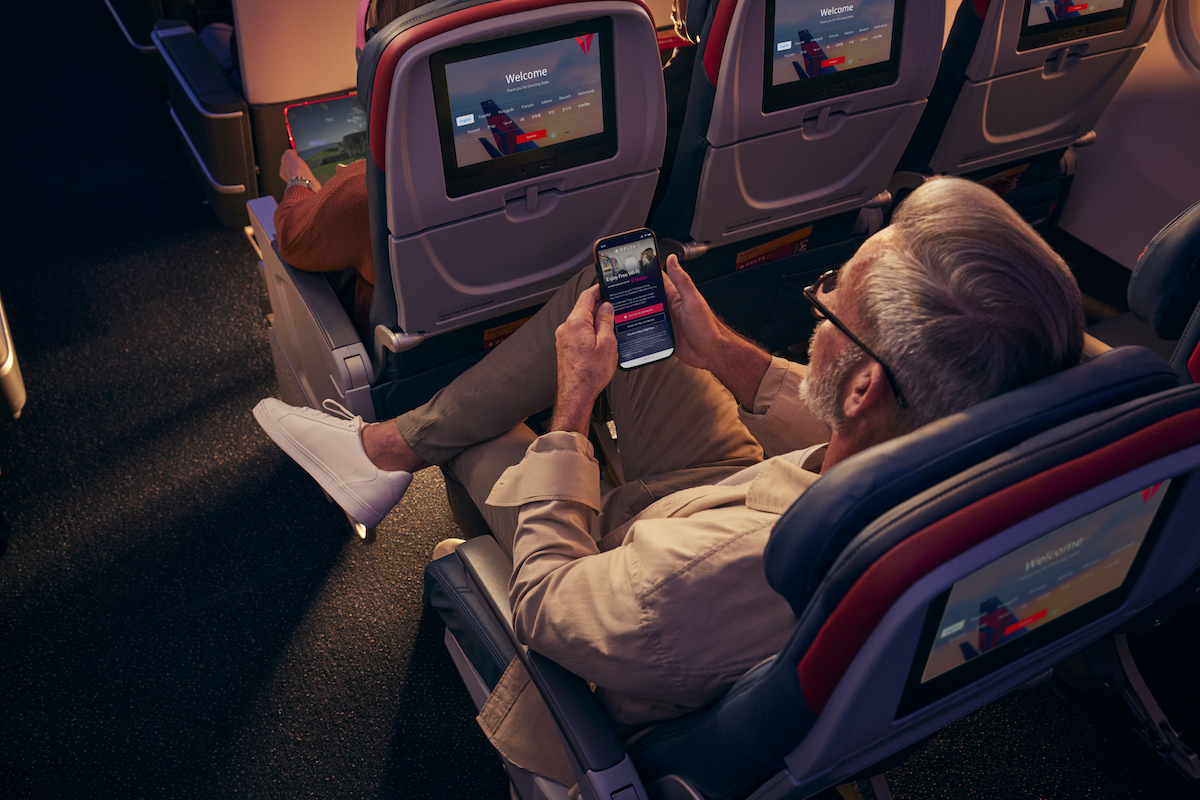Airlines Dole Out Free Wi-Fi in Exchange For Your Loyalty

Skift Take
Airlines can’t avoid Wi-Fi anymore: Travelers expect it, and they’re basing their flight choices on its quality and price.
It’s been a long way to this point. Boeing saw little success with its Connexion by Boeing service, launched in April 2000 and shelved in 2006. Now, big-name carriers have a reasonably fast Wi-Fi offering, including: Delta and United in the U.S., Air France/KLM and Lufthansa in Europe and Emirates, Qatar Airways and Singapore Airlines in Asia.
Early on, connectivity was lumpy and mostly unreliable whilst flying over water. However, with the emergence of behemoths such as those created by the acquisition of Inmarsat by Viasat, and the emergence of faster technology, such as the Ka-band, it has also become more steady, and the coverage area has increased. For instance, airlines that sign up for Panasonic’s inflight offerings have global coverage now.
The approach towards pricing for inflight Wi-Fi has changed as much as the speed.
Over the initial years, airlines used advertising or sponsorship deals to make the Wi-Fi free, such as tying up with a content streaming service like Prime Video or Apple TV+.
Another approach, which never became too popular, was selling data packages. The problem was customers could not predict how much data they would consume on a given flight. This pricing model still exists on many carriers but should be on its way out soon. JetBluebecame the first U.S. airline back in 2013 to offer free Wi-Fi to all passengers using its Fly-Fi offering. And this status quo did not change much for a long time until recently.
More recent Wi-Fi access models offer services such as iMessage and WhatsApp for free but apply flat pricing for full connectivity.
Buy for as low as $8-$10 for a single flight (Alaska Air, United and Southwest) or a subscription plan for the month, for instance, $50 on American Airlines for one device.
International carriers such as Qatar Airways offer their Super Wi-Fi package for the flight duration for $8 when pre-purchased and $10 on board. Carriers such as T-Mobile are rolling up Wi-Fi on most American full-service carriers as a part of their postpaid plans.
Free Wi-Fi, though, has been a gradual shift in the world of inflight internet as more stable connectivity solutions come online. And loyalty programmes have become the bridge between offering Wi-Fi and not charging for it. There are two primary ways this is structured, and the lookout depends on the airline.
Some airlines are using the carrot of free Wi-Fi to enable more sign-ups to their loyalty programmes. Ultimately, once a passenger becomes a member of the loyalty programme, the airline can engage with them in some form of a future transaction again, such as another trip or a credit card, or a sale of miles and so on.
For instance, Singapore Airlines extended free unlimited Wi-Fi service to all travelers in all cabin classes, including Premium Economy Class and Economy Class, from July 1, 2023. However, the free unlimited wifi for Economy/Premium Economy customers is offered only when they sign up for KrisFlyer, the loyalty program of SIA.
Delta rolled out free (full) Wi-Fi capabilities to SkyMiles members this year, enabled on their mainline domestic fleet. Delta intends to roll this out on international and regional aircraft by the end of 2024. Those who don’t want to enroll, can continue to pay to get access on board Delta aircraft.
Commenting on the move, a Delta spokesperson said, “Our vision at Delta has long been to deliver our customers a connected experience at 30,000 feet that feels similar to their experience on the ground. Requiring Delta SkyMiles Membership for free Wi-Fi access allows us to offer a personalized, unique and elevated experience different from what customers might find on other airlines with similar programs.”
Some airlines are looking at complimentary Wi-Fi as a reward for being a frequent flyer. For instance, Emirates offered unlimited free Wi-Fi to its premium cabin customers and its Platinum and Gold Tier members of the Skywards programme in 2017.
In January 2023, Emirates enhanced its Wi-Fi offering on board to offer all Emirates Skywards members in every class of travel some form of free connectivity. All Skywards members are now enabled to receive free app messaging services throughout the flight. Platinum members are still offered full Wi-Fi regardless of their cabin of service, while other elite members are provided full Wi-Fi when flying business class.
Per some numbers released by Emirates in May, the airline sees 450,000 users per month on average. In a comment to Skift, Patrick Brannelly, SVP Retail, IFE & Connectivity at Emirates, said, “Reaching for a credit card and entering details is a huge inhibitor to making any purchase inflight. Offering free connectivity based on authenticating via FFP sign-up saw about 30% more customers use the service every day. “
Inmarsat seems to concur. In a report titled “Disrupting the airline market: Free passenger Wi-Fi”, Inmarsat mentions that over the 15 years that inflight Wi-Fi has existed, the market has consistently suggested that passenger access should be instant, seamless and, above all, free to hit the 30% take-up threshold.
As Andrew Lewis said long ago, “If you're not paying for something, you're not the customer; you're the product being sold.”
This holds true for complimentary in-flight Wi-Fi as well. You might not be paying for the internet access in money. Still, you might be paying for it in terms of attention towards advertisements or attracting marketing emails in your inbox later, enabling the airline to monetise you. Hope more airlines crack the code sooner than later and are able to offer complimentary Wi-Fi on board.




